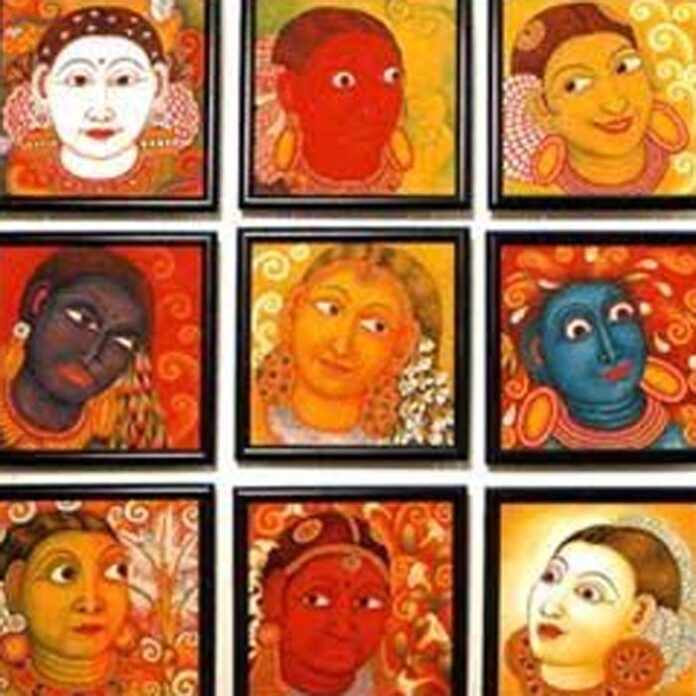- SreeRagam – 4
यथोहस्ततथोदृष्टि
Wherever your hands go, your eyes will follow
यथोदृष्टितथोमनः
Wherever your eyes go, your mind will follow
यथोमनःतथोभाव
Wherever your mind goes, there will be an expression of inner feeling
यथोभावतथोरस
Where expression is shown, there will be an arousal of an emotion or rasa
नाट्यशास्त्र
(Natya Shastra)
Indian classical music emanates an innate melody replete with emotions. The raga has a soul which conveys the emotion through the swaras. The emotion of the raga can be broadly understood as the rasa. Rasa literally has several connotations like flavour, taste, essence, flow, juice etc.
According to the Nātyaśāstra of Bharata (2nd century BC-2ndcentury AD), “rasa is the seed and fruit of the arts.” Bharata’s Natyasastra is the oldest testimonial for expounding the doctrine of rasa in its eight forms; Evocation of rasa through the rendition of a raga is the intrinsic characteristic exclusive to Indian Classical music.
Also Read : How ragas were classified
Sringara – love, romance
Sringara rasa is known as the king of all rasas. It evokes love, happiness, joy. Feeling of love is experienced in its myriad forms, the love for the beloved, love of a mother and also love for divinity. It is an aesthetic experience that elevates the human soul and refines the senses. Love is the pristine nature of human existence. It is rightly known as Rasa Raja as it is considered to be the ultimate of all emotions.
Ragas: Mohana, Kedaram, Mand, Suruti, Kalyani, Huseni, Kapi
Adbhuta– wonder
It is a rasa associated with curiosity, astonishment. Our existence in this universe is filled with inexplicable wonders. If only we try to retain the innocence of a child within ourselves, expressing awe at nature’s unfathomable wonders,adbhuta rasa can inculcate a sense of gratitude.
Ragas: Behag, Saranga, Bilahari, Malayamarutham
Veera – heroic, valour
Veer rasa is the rasa of fearlessness, determination, It depicts the perfect control of body and mind. Veera rasa is vital to take up challenges in life.
Ragas : Attana, Bilahari, Begada, Hamsadhwani, Kadanakutuhalam
Also Read : Raga: the soul of Indian Classical music
Raudra – Anger
Raudra rasa or anger is not just a negative trait. It becomes imperative for a mother to get angry to correct her child, or for a teacher to discipline his students. It has various connotations depending on the circumstances and temperament of an individual.
Ragas : Attana, Arabhi, Pantuvarali, Darbar
Bhayanaka – fear
Bhayanaka rasa includes fear and anxiety. Fear of unknown is often created by ignorance and over thinking. Building up confidence and inner strength can ward off fear and anxiety
Ragas: Punnagavarali, Chakravakam, Sarasangi
Karuna– empathy, kindness
Karunarasa is the rasa of sadness, the highest form of compassion. True compassion emanates from a feeling of inclusiveness of every living being into our periphery. It helps to inculcate a feeling of kindness.
Raga : Sahana, Nadanamakriya, Kanada, Varali, Saveri
Hasya – humour, laughter
Hasya rasa arises from a feeling of joy. Laughter is infectious and it creates an ambience of joy and happiness around us.
Ragas: Mohana, Kedaram. Hamsadhwani, Kuntalavarali
Bibhathsa – Disgust
Bibhatsa is a feeling of dissatisfaction or disgust with oneself or with others. It is expressed in the form of unruly manners, abusive language and perverted actions. Self-pity is dominant in this rasa.
Raga : Attana, Ahiri, Mayamalavagoul.
Shanta – Peace, tranquility, silence
Initially in Indian culture, Shanta rasa was not considered a rasa because it is the state of ni-rasa or absence of any emotion that would lead to the culmination of all rasas.
Shanta rasa depicts the power of peace. When the body, mind and soul are in harmony with each other, a peaceful, blissful state pervades
Also Read : Understanding Music
Shanta rasa was included only during third or fourth centuries and thus evolved Nava rasas.
Ragas : Vasanta, Syama, Yadukula Kambhoji, Surati
The whole spectrum of human existence is experienced in these navarasas. Rasa is not an abstract concept but an emotion conveyed through the flow of swaras in the raga.
Bharata elucidates that the experience of these basic emotions may be pleasant or unpleasant in reality, but when they are experienced (rasanubhava) and absorbed (tanmayibhavana) through any of the fine arts like music, they create an experience of delight, bliss, or ecstasy (ananda).
Taittariya Upanishad says,

Rasovaisah/rasam hyevayam labdhv aanadabhavati
The happiness derived by the experience of a rasa through music is not just materialistic. It is transcendental, soul-stirring and creates inner happiness.
Elaboration of a raga is an infinite field of exploration for the artist. It is up to the calibre, imagination and dedication of the musician to create ambience of exuberance among the listeners. Ultimately the aim of Indian classical music is experiencing divinity through ragas.





Navarasaalu mana jeevaitham lo chala pradhanamaina minahaa amsham.mana bhava vyakthikarnam cheyalante ee navarasaalu upayogam entho undi daniki ragam thodu ayite jivitham chala madhurantakam vuntundi rasamayanga sagutundi.Lakshmi meeru chala chakkga vivarinchaaru.Meeru ilaage marenno vishayalanu sprusinchalani korukuntunnaru.
Excellent
Thank you so much for this!